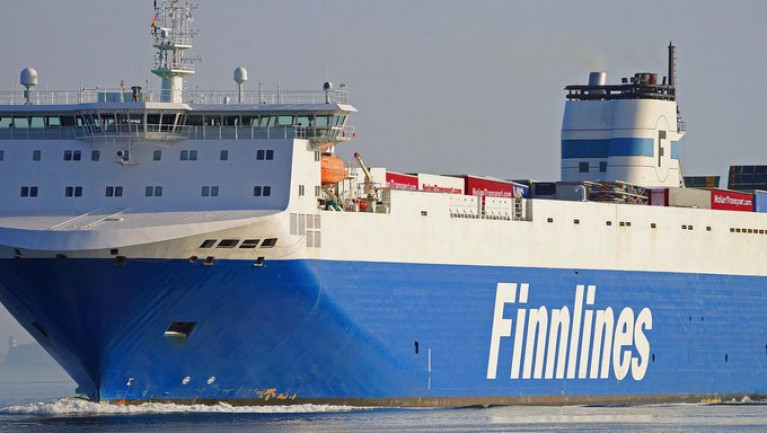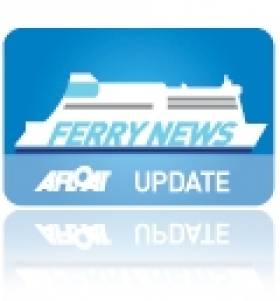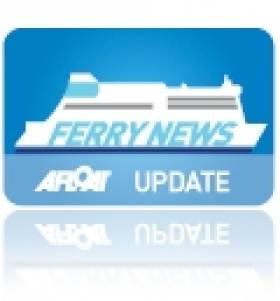Displaying items by tag: Finnlines
Ireland-Belgium Freight Service Expands from Rosslare
Shipping company Finnlines is expanding its Ireland-Belgium freight service between Rosslare and Zeebrugge.
A second ro-ro vessel has been added to the route, Iarnród Éireann, port authority for Rosslare Europort, has said.
MS Finnpulp will join MS Finnwave on the route, departing from Zeebrugge on February 23rd, it said.
It will “provide a significant increase of capacity on the direct connection between Ireland and mainland Europe”, it said.
Finnlines launched the new service between Rosslare Europort and Zeebrugge in July 2022.
“ The service has been well received by Irish transport operators and provides an important link for Irish industry,” Iarnród Éireann said.
Via transhipment in Zeebrugge, the Irish connection is also available to industry to and from the Finnish, German, Estonian and Spanish markets as well as the whole Grimaldi Group network.
“ We provide an excellent transport link for Irish trade to the Continent by offering tailor-made capacity for our customers whose business depends on reliable sea transportation services,” Finnlines Line Manager Antonio Raimo said.
“We are delighted with the announcement by Finnlines on their expansion plans from Rosslare Europort,” Glenn Carr, Rosslare Europort commercial manager, said.
 Glenn Carr, Rosslare Europort commercial manager
Glenn Carr, Rosslare Europort commercial manager
MS Finnpulp has a capacity for 3,259 lane metres of cargo, equivalent to around 225 trailers. MS Finnwave has a capacity for 4,192 lane metres, equivalent to around 300 trailers. Both vessels can also accommodate 12 drivers.
Finnlines specialises in freight transport, and its extensive line network provides European industry with regular and reliable sea connections, while ensuring the import of goods that are essential for the security of supply.
Departures
Rosslare Mon 03:00 – Zeebrugge Tue 11:00
Rosslare Thu 22:00 – Zeebrugge Sat 06:00
Rosslare Sat 14:00 – Zeebrugge Sun 22:00
Arrivals
Zeebrugge Tue 22:00 – Rosslare Thu 04:30
Zeebrugge Thu 22:00 – Rosslare Sat 04:00
Zeebrugge Sat 16:00 – Rosslare Sun 19:00
Finnlines to Enter Irish Market In Response to Freight Demand With New Rosslare Europort-Zeebrugge Link
As previously speculated, Finnlines is to open a new freight route of Rosslare Europort-Zeebrugge with the Belgium link also offering a new connection between Ireland and the Nordic nation.
On 23 July, Finnlines will launch the new service linking Ireland and mainland Europe and there will be two departures per week from each direction.
The route will be operated by the ro-ro vessel, Finnpulp, which has the capacity to carry 3,259 lane metres of cargo, equivalent to around 225 trailers. The vessel can also accommodate 12 drivers
Finnpulp, ship data
Ship type: ro-ro cargo
Built: 2002/2009
Length: 187 m
DWT: 11,682
GT: 25,732
Service speed: 20 knots
Demand for freight services from Ireland to Continental Europe has grown in the wake of Brexit and the new route will provide a crucial link for Irish industry. The Finnish industry, as well as German and Spanish industries, will also have an easier access to Ireland via transshipment in Zeebrugge.
“We are delighted to support the growing post-Brexit Irish trade to the Continent and provide transport operators with an important alternative route, which will greatly benefit all stakeholders and the Irish economy. Finnlines provides cost-efficient and high frequency liner services to its customers with the lowest CO2 emissions per transported cargo unit, ” says Antonio Raimo, Line Manager at Finnlines.
“Finnlines is proud to expand its route network and upgrade its services to support its customers to grow and develop new businesses,” confirms Tom Pippingsköld, Finnlines President and CEO.
Finnlines specialises in freight transport and the extensive line network provides Finland’s export industry with a regular and reliable way to the European market, while ensuring imports of goods that are important for security of supply.
Activity at Rosslare Europort which has exploded post-Brexit is continuing in earnest with yet another new route set to be announced for the Wexford ferry port.
According to Wexford People, it’s been reported that Finnlines are now set to operate a twice weekly Ro-Ro freight service between Rosslare and the Belgian port of Zeebrugge commencing in July of this year.
However, Rosslare Europort management (see press release below) are insisting that a deal has not been concluded yet, although they are in “advanced discussions” with Finnlines. They stressed that “while agreement has not yet been reached, Rosslare Europort is optimistic that this new route can be established to give yet another crucial link for Irish industry to and from mainland Europe.”
The addition of a route to the Belgian port has been rumoured for quite some time as demand for sailings to continental Europe continues to grow in the wake of Brexit. It appears that it is now coming to fruition as a result of consultations between New Ross based Nolan Transport and Finnlines, although the transport company may have jumped the gun slightly with their announcement.
More reports Wexford People which as alluded above referred to Rosslare Europort which today (2 June) issued a press release as also below:
In response to speculation, Glenn Carr, General Manager, Rosslare Europort has confirmed that Port management are in advanced discussion with Finnlines – part of the world-leading logistics and shipping Grimaldi Group – about a possible new connection between the Co Wexford port and the Belgian port of Zeebrugge, one of Europe’s largest RoRo ports.
Port management have stressed that while agreement has not yet been reached, Rosslare Europort is optimistic that this new route can be established to give yet another crucial link for Irish industry to and from mainland Europe.
Since Brexit, Rosslare Europort has established itself as Ireland’s Gateway to Europe, with the highest RoRo volumes of any Irish port to/from the continent during 2021. Rosslare Europort continues to engage with new and established shipping lines and with partner ports in Europe as it seeks to further build the range of services operating from the port.
#Cobelfret – Finnlines have acquired ro-ro freighter Dorset from Cobelfret, which spent a brief spell late last year (see report/photo) on their Irish operations, Dublin- Zeebrugge and also to Rotterdam, writes Jehan Ashmore.
The sale to Finnlines earlier this year sees the 2,606 lane-metre vessel renamed Finnmerchant of 23,235 tonnes serve a new Baltic Sea route between Hanko,Finland and Rostock, Germany.
In addition the move to Scandinavia comes only a year later to when a Cobelfret subsidiary, C-Bulk Shipping purchased the 2003 built vessel launched as Longstone along with sister, Beachy Head.
It was in the previous spring of 2013 that the pair become surplus to the UK's Ministry of Defence (MoD) requirements as part of a Private Finance Initiative contract involving all six 'Point' class sisters.
The sale in 2014 of Longstone to Cobelfret and renaming as Dorset followed a career with Foreland Shipping. That operator was previously Andrew Weir Shipping (AWSR Ltd) who originally ordered the vessel as part of quartet of Point class sisters from FGS yard in Flensberg, Germany.
The remaining Point-class pair where built by Harland & Wolff which completed Hartland Point first. Her sister, Anvil Point made history as she became the last ever ship to be completed at the famous yard when she was launched into Belfast Lough in 2003.
Another Irish connection with the Scandinavian operator came in the form of Celtic Ferries, whose ro-ro freighter, Finnforest, was chartered to serve in the Baltic.
Finnforest was originally built for Stena as one of the 'Searunner' class in which a sister, Diplomat became Celtic Link Ferries first ship running Rosslare-Cherbourg sailings.
Celtic Link Ferries final Ireland-France sailing came to an end more than a year ago (March 31, 2014).
From thereon, the operations of CLF were officially acquired by Stena Line and this included the chartered Celtic Horizon on the 17 hour crossing.
The ro-pax was given a revised renaming, Stena Horizon and marked the operators first ever Ireland-mainland European route.
Chartered Finnish Ferry Heads for Scotland following Incident
#FinnishFerry –Following an inspection of Finnarrow due to a 'stabiliser incident' in Holyhead at the weekend, the chartered Finnish ferry requires further attention. The 25,996 tonnes vessel, having departed Anglesey today with a tug bound for Scotland, writes Jehan Ashmore.
As previously reported on Afloat.ie, Stena Line yesterday reactivated the fastcraft HSS Stena Explorer, with an earlier than planned opening of the Dun Laoghaire-Holyhead, a seasonal-only operated service which otherwise would not resume until late March.
In the meantime Stena Explorer is providing back-up operations for passengers, in the absence of Finnarrow sailings on the Dublin Port-Holyhead route. A second route ferry, Stena Adventurer, is as usual maintaining sailings on the Dublin Port-Holyhead route.
Passengers due to travel with Stena Line should note the 'latest' information on sailing times. In addition passengers should take particular note of certain sailings for 'foot' passengers and 'vehicle-only' sailings. For information visit: www.stenaline.ie/ferry/latest-sailing-information/
The 'Adventurer's fleetmate Stena Nordica firstly headed for the St. Georges Channel route, having been replaced on the Dublin route by the chartered Finnarrow in late January.
Stena Nordica is currently running Belfast-Cairnryan sailings, while the 'Superfast' sisters each take turns for annual maintenance at Harland & Wolff, Belfast.
Ferry Circles Dublin Bay Buoy in Readiness for Refit
#FERRY REFIT – In readiness for annual refit, Stena Line's Dublin-Holyhead two-ship service, is to be relieved shortly by a chartered Finnish ro-pax ferry, Finnarrow (1996/25,996grt) which carried out 'berthing trials' in Dublin Port yesterday, writes Jehan Ashmore.
When the Stena Nordica (2000/24,206grt) is away in dry-dock, Finnarrow will take her roster in tandem with the route's second ro-pax Stena Advanturer. The relief ferry is owned by Finnlines and she has a 274 passenger capacity, space for 800 cars and can handle 154-freight trailer units.
In order for Finnarrow to perform berthing procedures at the single linkspan used exclusively by Stena Line at Dublin Ferryport (Terminal 2), the Stena Nordica departed the port into the rough sea of Dublin Bay. During this time she circled the Dublin Bay Buoy and throughout the bay, before returning to the berth just vacated by Finnarrow, so to resume her scheduled afternoon sailing to Holyhead.
Finnarrow had earlier this week set sail from the German Baltic Sea port of Travemünde and arrived at the Welsh port on Wednesday lunchtime, where she also undertook berthing trails.
Ironically both Stena Nordica and Finnarrow served together on Stena Line's Karlskrona-Gdyania route several years ago, where the latter vessel was also chartered out on their Harwich-Hook van Holland route.
The Finnarrow, which unusually for a Scandinavian operator, was built in Indonesia, when ordered for original owners Rederi AB Gotland. Under her current role, she is part of the Finnlines (Grimaldi Group) of operations running 14 ro-pax vessels between six countries and eleven ports throughout the Baltic and North Sea.
Celtic Charter Finnforest to Italians
The Finnforest has since 1999 served several Scandinavian routes. In 2008 Celtic Link Ferries purchased the Finnforest and continued chartering arrangements with Finnlines on the Helsinki-Gdynia route in the Baltic Sea. The charter ceased earlier this year with the vessel returning to Dublin for dry-docking in July. The Finnforest then proceeded into lay-up in Waterford. On the 30 September the Finnforest departed Waterford's city-centre quays bound for the Mediterranean Sea.
Also joining Finnforest on the Naples-Palermo route are the passenger cruise ferries SNAV Snav Lazio and Snav Sardegna which were transferred in early October from another route of SNAV (Societa Navigazione Alta Velocita) extensive ferry network of services from Italy to Corsica, Sardinia, Croatia and Sicily.
The cruise ferries vessels had previously served on P&O Ferries English Channnel route as sisters Pride of Portsmouth and Pride of Le Havre. Launched for Olau Line, the German built twins replace the SNAV Campania and SNAV Sicilia, former North Sea Ferries (later P&O Ferries) sisters Norland and Norstar. The sisters were withdrawn from the Naples-Palermo service and are reported to have sailed for Jeddah. It is uncertain if the 1973 built pair will see further service in the Red Sea or are heading further east.
The Finnforest was built in South Korea as one of the successful 'Searunner' class of vessels ordered by Stena Rederi during the 1970's. Finnforest's half-sister Diplomat (1978/16,776grt) is on charter too by the Wexford based company. The Diplomat had operated Celtic Link Ferries Rosslare-Cherbourg route until late 2009 before also going to lay-up at Waterford. In April, the Diplomat was chartered to Marine Express to operate in the Caribbean on routes between Peurto Rico and the Dominican Republican.
In 2008 Louis Dreyfus Armateurs ferry subsidiary LD Lines chartered the new 26,500 grt ro-pax Norman Voyager from Liverpool based Meridian Marine Management for the Portsmouth-Le Havre route. In addition a Le Havre-Rosslare round-trip was scheduled at the weekends. LD Lines then switched the French port to neighbouring Cherbourg. The service to Ireland was short-lived with the French company abandoning the route. Subsequently the Norman Voyager was was sub-chartered by LD Lines to Celtic Link Ferries. The 800 passenger / 200 vehicle /120 truck ro-pax currently operates three sailings per week in each direction.

































































